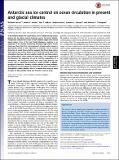| dc.contributor.author | Ferrari, Raffaele | |
| dc.contributor.author | Jansen, Malte Friedrich | |
| dc.contributor.author | Adkins, Jess F. | |
| dc.contributor.author | Stewart, Andrew L. | |
| dc.contributor.author | Thompson, Andrew F. | |
| dc.contributor.author | Burke, Andrea, Ph. D. Massachusetts Institute of Technology | |
| dc.date.accessioned | 2015-01-07T20:30:32Z | |
| dc.date.available | 2015-01-07T20:30:32Z | |
| dc.date.issued | 2014-06 | |
| dc.date.submitted | 2013-12 | |
| dc.identifier.issn | 0027-8424 | |
| dc.identifier.issn | 1091-6490 | |
| dc.identifier.uri | http://hdl.handle.net/1721.1/92743 | |
| dc.description.abstract | In the modern climate, the ocean below 2 km is mainly filled by waters sinking into the abyss around Antarctica and in the North Atlantic. Paleoproxies indicate that waters of North Atlantic origin were instead absent below 2 km at the Last Glacial Maximum, resulting in an expansion of the volume occupied by Antarctic origin waters. In this study we show that this rearrangement of deep water masses is dynamically linked to the expansion of summer sea ice around Antarctica. A simple theory further suggests that these deep waters only came to the surface under sea ice, which insulated them from atmospheric forcing, and were weakly mixed with overlying waters, thus being able to store carbon for long times. This unappreciated link between the expansion of sea ice and the appearance of a voluminous and insulated water mass may help quantify the ocean’s role in regulating atmospheric carbon dioxide on glacial–interglacial timescales. Previous studies pointed to many independent changes in ocean physics to account for the observed swings in atmospheric carbon dioxide. Here it is shown that many of these changes are dynamically linked and therefore must co-occur. | en_US |
| dc.description.sponsorship | National Science Foundation (U.S.) | en_US |
| dc.description.sponsorship | Massachusetts Institute of Technology (Breene M. Kerr Chair) | en_US |
| dc.language.iso | en_US | |
| dc.publisher | National Academy of Sciences (U.S.) | en_US |
| dc.relation.isversionof | http://dx.doi.org/10.1073/pnas.1323922111 | en_US |
| dc.rights | Article is made available in accordance with the publisher's policy and may be subject to US copyright law. Please refer to the publisher's site for terms of use. | en_US |
| dc.source | PNAS | en_US |
| dc.title | Antarctic sea ice control on ocean circulation in present and glacial climates | en_US |
| dc.type | Article | en_US |
| dc.identifier.citation | Ferrari, Raffaele, Malte F. Jansen, Jess F. Adkins, Andrea Burke, Andrew L. Stewart, and Andrew F. Thompson. “Antarctic Sea Ice Control on Ocean Circulation in Present and Glacial Climates.” Proceedings of the National Academy of Sciences 111, no. 24 (June 2, 2014): 8753–8758. | en_US |
| dc.contributor.department | Massachusetts Institute of Technology. Department of Earth, Atmospheric, and Planetary Sciences | en_US |
| dc.contributor.mitauthor | Ferrari, Raffaele | en_US |
| dc.contributor.mitauthor | Jansen, Malte Friedrich | |
| dc.relation.journal | Proceedings of the National Academy of Sciences of the United States of America | en_US |
| dc.eprint.version | Final published version | en_US |
| dc.type.uri | http://purl.org/eprint/type/JournalArticle | en_US |
| eprint.status | http://purl.org/eprint/status/PeerReviewed | en_US |
| dspace.orderedauthors | Ferrari, Raffaele; Jansen, Malte F.; Adkins, Jess F.; Burke, Andrea; Stewart, Andrew L.; Thompson, Andrew F. | en_US |
| dc.identifier.orcid | https://orcid.org/0000-0002-3736-1956 | |
| mit.license | PUBLISHER_POLICY | en_US |
| mit.metadata.status | Complete | |
